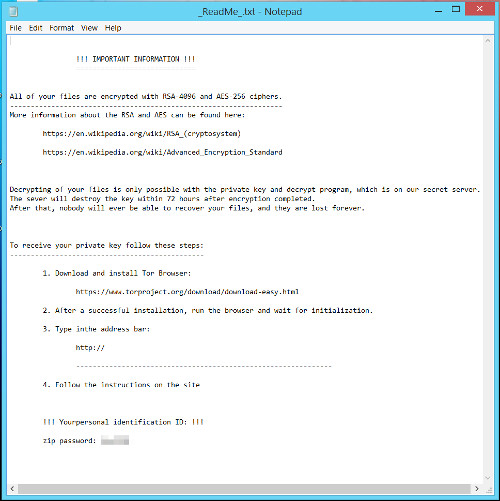RANSOM_FAKELOCKY.A
Win32/Filecoder.ArmaLocky.A trojan (NOD32);
Windows


Threat Type: Ransomware
Destructiveness: No
Encrypted: No
In the wild: Yes
OVERVIEW
This Ransomware encrypts files found in specific folders. It drops files as ransom note.
TECHNICAL DETAILS
252,416 bytes
EXE
No
02 Sep 2017
Displays windows, Encrypts files
Autostart Technique
This Ransomware adds the following registry entries to enable its automatic execution at every system startup:
HKEY_CURRENT_USER\SOFTWARE\Microsoft\
Windows\CurrentVersion\Run
locky = {malware path}
Other System Modifications
This Ransomware adds the following registry entries:
HKEY_CLASSES_ROOT\.armadilo1\shell\
Open with Internet Explorer\command
HKEY_CLASSES_ROOT\.armadilo1
HKEY_LOCAL_MACHINE\SOFTWARE\Microsoft\
Windows NT\CurrentVersion\SystemRestore
DisableSR = 1
It modifies the following registry entries:
HKEY_LOCAL_MACHINE\SYSTEM\CurrentControlSet\
Services\srservice
Start = "0x00000004"
(Note: The default value data of the said registry entry is "0x00000002".)
HKEY_LOCAL_MACHINE\SYSTEM\CurrentControlSet\
Services\swprv
Start = "0x00000004"
(Note: The default value data of the said registry entry is "0x00000003".)
HKEY_LOCAL_MACHINE\SYSTEM\CurrentControlSet\
Services\vss
Start = "0x00000004"
(Note: The default value data of the said registry entry is "0x00000003".)
Dropping Routine
This Ransomware drops the following files:
- %Desktop%\install.log
(Note: %Desktop% is the desktop folder, where it usually is C:\Documents and Settings\{user name}\Desktop in Windows 2000, Windows Server 2003, and Windows XP (32- and 64-bit); C:\Users\{user name}\Desktop in Windows Vista (32- and 64-bit), Windows 7 (32- and 64-bit), Windows 8 (32- and 64-bit), Windows 8.1 (32- and 64-bit), Windows Server 2008, and Windows Server 2012.)
Ransomware Routine
This Ransomware encrypts files found in the following folders:
- {Drive Letter}:\
It avoids encrypting files with the following strings in their file name:
- .exe
- .dll
It avoids encrypting files with the following strings in their file path:
- %System Root%\windows
- %System Root%\boot
- %System Root%\msocache
- %System Root%\config.msi
(Note: %System Root% is the Windows root folder, where it usually is C:\ on all Windows operating system versions.)
It appends the following extension to the file name of the encrypted files:
- .armadilo1
It drops the following file(s) as ransom note:
- {folder of encrypted files}\_ReadMe_,txt
- %Desktop%\_Locky_HELP_.html
(Note: %Desktop% is the desktop folder, where it usually is C:\Documents and Settings\{user name}\Desktop in Windows 2000, Windows Server 2003, and Windows XP (32- and 64-bit); C:\Users\{user name}\Desktop in Windows Vista (32- and 64-bit), Windows 7 (32- and 64-bit), Windows 8 (32- and 64-bit), Windows 8.1 (32- and 64-bit), Windows Server 2008, and Windows Server 2012.)
NOTES:
This ransomware executes the following commands as part of its preparation for encrypting files:
- -vssadmin delete shadows /for={drive letter} /all /quiet
- -schtasks /Change /TN Microsoft\Windows\SystemRestore\SR /Disable
- -sc config swprv start= disabled
- -sc config vss start= disabled
- -sc stop vss
- -Reg add HKEY_LOCAL_MACHINE\SOFTWARE\Microsoft\Windows NT\CurrentVersion\SystemRestore /v DisableSR /t REG_DWORD /d 1 /f
- -sc config srservice start= disabled
- -net stop srservice
The ransom note file %Desktop%\_Locky_HELP_.html contains:

The ransom note file {folder of encrypted files}\_ReadMe_,txt contains:

SOLUTION
9.850
13.652.08
11 Sep 2017
13.653.00
12 Sep 2017
Step 1
Before doing any scans, Windows XP, Windows Vista, and Windows 7 users must disable System Restore to allow full scanning of their computers.
Step 2
Note that not all files, folders, and registry keys and entries are installed on your computer during this malware's/spyware's/grayware's execution. This may be due to incomplete installation or other operating system conditions. If you do not find the same files/folders/registry information, please proceed to the next step.
Step 3
Delete this registry key
Important: Editing the Windows Registry incorrectly can lead to irreversible system malfunction. Please do this step only if you know how or you can ask assistance from your system administrator. Else, check this Microsoft article first before modifying your computer's registry.
- HKEY_CLASSES_ROOT\.armadilo1
Step 4
Delete this registry value
Important: Editing the Windows Registry incorrectly can lead to irreversible system malfunction. Please do this step only if you know how or you can ask assistance from your system administrator. Else, check this Microsoft article first before modifying your computer's registry.
- In HKEY_CURRENT_USER\SOFTWARE\Microsoft\Windows\CurrentVersion\Run
- locky = {malware path}
- locky = {malware path}
- In HKEY_LOCAL_MACHINE\SOFTWARE\Microsoft\Windows NT\CurrentVersion\SystemRestore
- DisableSR = "1"
- DisableSR = "1"
Step 5
Restore this modified registry value
Important: Editing the Windows Registry incorrectly can lead to irreversible system malfunction. Please do this only if you know how to or you can seek your system administrator’s help. You may also check out this Microsoft article first before modifying your computer's registry.
- In HKEY_LOCAL_MACHINE\SYSTEM\CurrentControlSet\Services\srservice
- From: Start = "0x00000004"
To: Start = "0x00000002"
- From: Start = "0x00000004"
- In HKEY_LOCAL_MACHINE\SYSTEM\CurrentControlSet\Services\swprv
- From: Start = "0x00000004"
To: Start = "0x00000003"
- From: Start = "0x00000004"
- In HKEY_LOCAL_MACHINE\SYSTEM\CurrentControlSet\Services\vss
- From: Start = "0x00000004"
To: Start = "0x00000003"
- From: Start = "0x00000004"
Step 6
Search and delete these files
- {folder of encrypted files}\_ReadMe_,txt
- %Desktop%\_Locky_HELP_.html
Step 7
Scan your computer with your Trend Micro product to delete files detected as RANSOM_FAKELOCKY.A. If the detected files have already been cleaned, deleted, or quarantined by your Trend Micro product, no further step is required. You may opt to simply delete the quarantined files. Please check this Knowledge Base page for more information.
Step 8
Restore encrypted files from backup.
Did this description help? Tell us how we did.

